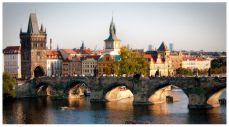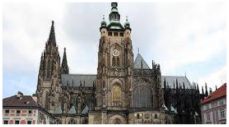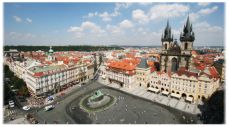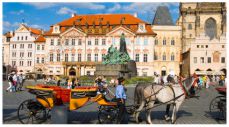In Czech towns and villages, you’ll find a simple joy of life. The magic of Prague, the beauty of Český Krumlov, and the lyrical quality of the countryside relieve the heaviness caused by the turmoil that passed through here. Get beyond Prague and explore the country’s medieval towns. These rugged woods and hilltop castles will make you feel as if you’re walking through the garden of your childhood dreams.
At a Glance
PLAN YOUR TOUR
3 Days:Prague 4-5 Days, add:Your choice of nearby day trips (Kutná Hora, Terezín Memorial, Karlovy Vary, and three castles: Konopiště, Karlštejn, or Křivoklát) 5 Days, add: Český Krumlov (and skip day trips) 7 Days, add:Olomouc
Things To Do:
*Prague The Czech capital and one of Europe’s most romantic cities, boasting a remarkably well-preserved Old Town with top-notch architecture from every era; a sprawling hilltop castle; a thriving New Town packed with slinky Art Nouveau facades; a historic and well-presented Jewish Quarter; inspiring tales from its rocky late-20th-century history; countless lively pubs serving some of the world’s best beer; and enough museums, churches, gardens, and other attractions to entertain any visitor.
*Day Trips from Prague A wide range of easy side-trips, including Kutná Hora, a workaday Czech town with an offbeat bone church, stunning cathedral, and silver mining museum; Terezín, a sobering memorial to the victims of the Nazis; Konopiště Castle, the opulent but lived-in former residence of the Archduke Franz Ferdinand; dramatically situated Karlštejn Castle; the genuinely Gothic hunting palace of Křivoklát Castle; and the swanky spa town of Karlovy Vary (Carlsbad).
*Český Krumlov Charming, picturesque, and popular midsized town huddled under a colorful castle and hugging a river bend in the Bohemian hills, made to order for canoeing, hiking, and people-watching.
*Třeboň, Telč, Třebíč, and Slavonice Four different southern Bohemian towns, each with a claim to fame: Třeboň, surrounded by artificial lakes; Telč, with a spectacular main square; Třebíč, with echoes of Jewish history; and — huddled along the Austrian border — Slavonice, with evocative, never-used WWII fortifications.
*Olomouc Moravian cultural capital and thriving university city, with a grand square (crowned by Europe’s biggest plague column), churches, museums, famously pungent cheese, bustling everyday life, and the country’s top Rococo château in nearby Kroměříž.
*Wallachia Time-passed, mountainous corner of Moravia, with a fine open-air folk museum at Rožnov pod Radhoštěm and a mountaintop retreat at Pustevny.
*Mikulov Wine Region The Czech Republic’s top wine-growing area, with a trio of worthwhile stops within a few minutes’ drive: the historical town of Mikulov (postcard-perfect main square and vibrant Jewish sites), the humble village of Pavlov (wine cellars), and the impressive castles-and-gardens complex of Lednice and Valtice.
When to Go
In Prague and the Czech Republic, the “tourist season” runs roughly from Easter through October. July and August have their advantages, with the best weather, longer days (daylight until after 21:00), fewer tourists in Prague than in the peak months of May, June, and September, and busy festivals held in small towns around the country. In spring and fall (May, June, Sept, and early Oct), the weather is milder, and the colors and scents are more powerful. Winter travelers find the concert season in full swing, with remarkably fewer tourists — but outside of Prague, many sights are either closed or open on a limited schedule. In December, you’ll find Christmas markets on main squares around the country, fragrant with the scent of hot wine with cloves. After a quiet Christmas season, Prague explodes with fun on New Year’s Eve, teeming with thousands of Germans and other Europeans. In January and early February, when few tourists come, chances are you will wake up to a Prague silenced by the wistful glimmer of snow, which quickly melts in the Old Town but stays on the ground at Prague Castle and on top of Petřín Hill. Seeing the Charles Bridge blanketed by fresh snow makes the hours spent out in the cold worthwhile. Frequent pub stops, with lots of plum brandy and hot wine, are essential at this time of year — and they bring you closer to local life. Winter can linger, but Prague usually turns green with spring around mid-April.






